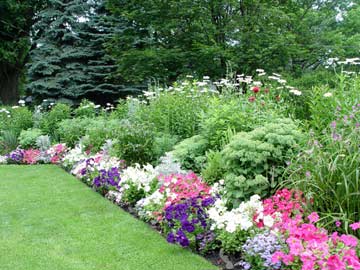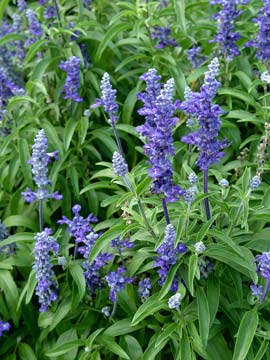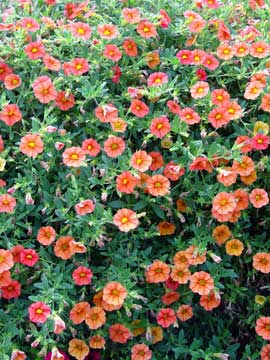Soft, pastel shades making a comeback to counteract hyper lifestyles
 Calming colors such as blue and soft pink are shaping up as the trends for 2015.
Calming colors such as blue and soft pink are shaping up as the trends for 2015.
© George Weigel
Just as in fashion, color trends change over time in the garden. For 2015, gardeners look to be leaning toward soft, pastel, calming shades to counteract hectic, always-plugged-in lifestyles. That’s the latest forecast from the Pantone Color Institute, the New Jersey-based world authority on everything color.
Pantone says 2015’s hot colors won’t be hot, instead leaning toward cooler shades of blue, soft blue, pastel green, creamy-white, muted pink and tangerine. In "official" Pantone names, the top 10 colors of 2015 will be aquamarine, scuba blue, lucite green, classic blue, toasted almond, strawberry ice, tangerine, custard, marsala and glacier gray. "Many (people) feel compelled to be connected around the clock because we are afraid we’ll miss something important," says Leatrice Eiseman, Pantone’s executive director. "There is a growing movement to step out and create "quiet zones" to disconnect from technology and unwind, giving ourselves time to stop and be still. Color choices follow the same minimalistic theme, taking a cue from nature rather than being reinvented or mechanically manipulated. Soft, cool hues blend with subtle warm tones to create a soothing escape from the everyday hustle and bustle."
In the garden, annual flowers are the quickest, easiest way to stay in tune with changing trends from year to year. Unlike perennials and shrubs that can live for years or even decades, annuals complete their life span in a single season. Plant them in spring, watch them flower all growing season, then frost kills them in fall. The scheme can then be completely changed for the next cycle.
 Salvia 'Signum' is an annual flower with nearly true-blue blooms all growing season.
Salvia 'Signum' is an annual flower with nearly true-blue blooms all growing season.
© George Weigel
In warmer parts of the United States, two sets of annuals offer year-round color – heat-loving types from spring to fall and cool-preferring pansies, violas, dusty miller and snapdragons over winter. Keep annuals consistently damp – especially those growing in pots and hanging baskets – and fertilize them every 4 to 6 weeks with a long-acting, granular plant fertilizer.
Flower breeders have made it easier than ever to shop by color by coming up with new and ever-widening ranges of hues throughout many species. Geraniums, for example, range from hot reds to soft pink with scores of shades between. Petunias range from white at one end of the spectrum to nearly black at the other. And impatiens have been bred in almost every color except true blue and black.
Blue is one of the least common flower colors, especially in shrubs and trees. Since it’s one of 2015’s leading shades, look to annuals for ample choices. In sunny spots, blue options include ageratum, blue salvia, agapanthus, angelonia (sometimes called “angel wings”), scaevola, evolvulus and vinca. In shadier spots, browallia is the best blue option, while in cool weather, lobelia and pansies are good options.
 Million bells, such as this Superbells® Dreamsicle, offer one of the few options in flowers with peachy to soft tangerine blooms.
Million bells, such as this Superbells® Dreamsicle, offer one of the few options in flowers with peachy to soft tangerine blooms.
© George Weigel
Soft pink offers many more annual-flower choices, ranging from alyssum, angelonia, celosia, geranium, globe amaranth, million bells, nicotiana, pentas, petunia, verbena, vinca and zinnia in sunny spots to impatiens, New Guinea impatiens, begonia, cleome and ivy geranium in shadier Nicotiana and zinnia are two annuals that come in soft-green flower options; million bells and verbena are two options that fit into the peach/tangerine/soft-orange shades, and marigold and petunia are two that come in creamy-white variations.
Dusty miller and a trailer called dichondra Silver Falls™ are two annuals with silvery-gray foliage that fit into Pantone’s glacier gray shade.
Color-shopping for annuals is easier than with most flowers because growers have learned how to time and induce annuals so they’re already in bloom at the garden center. In other words, no guessing or going only by the pictures.
If you’re looking to go longer-term with 2015’s shades, here are some perennial and shrub options in soft colors:
Perennials: astilbe, aster, beebalm, bleeding heart, coralbells, coreopsis, creeping phlox, delphinium, dianthus, foamflower, gaura, hibiscus, Joe Pye weed, lamium, liatris, lily, garden phlox and helleborus (pink); baptisia, balloon flower, bluestar, brunnera, campanula, catmint, gentian, forget-me-not, hardy geranium, iris, leadwort, pulmonaria, salvia and veronica (blue); astilbe, bleeding heart, candytuft, coralbells, daylily, foamflower, gaura, lily, mum and turtlehead (creamy-white); euphorbia and lady’s mantle (pastel green), and agastache and yarrow (soft orange).
Shrubs: abelia, beautyberry, beautybush, crape myrtle, deutzia, hydrangea, lilac, loropetalum, rose, spirea and weigela (pink); butterfly bush, caryopteris, clematis, hydrangea and vitex (blue); cherry laurel, deutzia, fothergilla, oakleaf hydrangea, panicle hydrangea, rose, summersweet and viburnum (creamy-white), and rose, tree peony and flowering quince (soft orange).